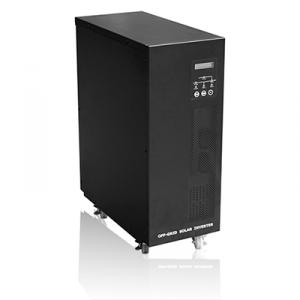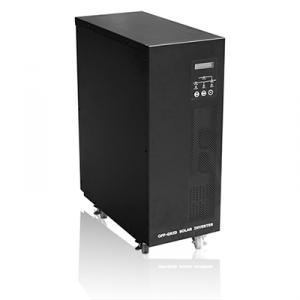Off-Grid Solar Inverter 3KW-8KW CE Approved AAA Quality with Best Price
- Loading Port:
- China main port
- Payment Terms:
- TT or LC
- Min Order Qty:
- 1 pc
- Supply Capability:
- 1000 pc/month
OKorder Service Pledge
OKorder Financial Service
You Might Also Like
Off-Grid Solar Inverter 3KW-8KW
EA-GF series products are on the basis of green energy use and equipment electricity need for remote area, combing the electricity characteristics of household appliances, communication station equipment and computer peripheral equipment. They have the function of energy conservation and environment protection. They adopt MCU control technique, having various kinds of function such as multi-setting mode, MPPT control, voltage stabilization on line, short-circuit protection, inverter frequency adaptive, output overload, battery charging management, monitoring etc. With display of LCD and LED, all the parameters and running status could be visible. Intelligent monitor is available via RS232 &USB connecting with PC, while remote control via RS485 &SNMP. EA-GF series products are the ideal power supply delivered with excellent performance, high stability, high reliability and high practical applicability
● Multi-setting
※PV priority mode or AC priority mode
※Choose the charging current based on the configured capacity of the battery
● High reliability: Double MCU digital control
※Independent MPPT (Maximum Power Point Tracking) control microprocessor system
※Independent inverter microprocessor control system
● Isolated and pure sine wave technology
● LCD+LED display
● Wide input range
● High-speed synchronous conversion
● Friendly alarm system
● Online protection function
● Frequency auto adaptive
● Intelligent No-load auto shutdown technology (optional)
● Intelligent monitoring (RS232, USB, or SNMP card, optional)
Model | GF3000 | GF4000 | GF3000 | GF5000 | GF6000 | GF8000 |
Power | 3KW | 4KW | 3KW | 5KW | 6KW | 8KW |
Battery Voltage | 96Vdc | 192Vdc | ||||
Working Mode | PV priority / AC priority optional | |||||
PV | ||||||
MPPT Voltage Range | 96Vdc - 200Vdc | 192Vdc - 400Vdc | ||||
Max. Charge Current | 10-60A | 10-40A | 10-60A | |||
PV Panels Configuration(Suggestion)(Vmp) | 120-142Vdc | 240-284Vdc | ||||
PV Panels Configuration(Suggestion)(Imp) | ≤60A | ≤40A | ≤60A | |||
Conversion Efficiency | ≥ 98 % | |||||
Display | ||||||
Panel Indicator | LCD+LED Panel display | |||||
AC Mode | ||||||
Input Voltage Range | 165Vac- 275Vac | |||||
Input Frequency Range | 40-70 Hz (auto transfer to battery mode, if beyond this range) | |||||
Output Voltage Precision | 220Vac± 5% | |||||
Input Power Factor | ≥0.8 | |||||
Max. Efficiency | 88% (inverter on) | |||||
Overload | 110% transfer to bypass in 255s,120% go to bypass in 60s, 150% go to bypass in 10s. | |||||
Max. Charging Current | 8A | 12A | ||||
Short Circuit Protection | Electronic limited current output or turn bypass, air breaker protection | |||||
Inverter Mode | ||||||
Output Voltage | 220Vac± 5% | |||||
Output Frequency | 50 Hz / 60Hz ± 1% Frequency self-adjusted | |||||
Output Power Factor | 1 | |||||
Distortion | ≤ 5% Linear load | |||||
PV-AC Transfer Time | 0ms | |||||
Max.Efficiency | ≥92% | |||||
Overload | 110% transfer to bypass, in 255s or shut down,120% go to bypass or shut down in 60s, 150% go to bypass or shut down in 10s. | |||||
Eco Mode(Optional) | When Load < 5%, system will turn to bypass power supply (utility) in 1min | |||||
Short Circuit | Electronic limited current output, turn the bypass or system to be automatic shutdown | |||||
Alarm | ||||||
AC Fails | 1/4s; automatic sound elimination after 40s | |||||
Battery Low Voltage | 5/1s | |||||
Overload | 1/1s | |||||
Communication (Optional) | ||||||
Communication Interface | RS232 / USB / RS485 / SNMP | |||||
Dry Contact | PV failure、battery low-voltage、overload、bypass、inverter failure、 remote start generator dry contact signal | |||||
Others | ||||||
Output Connection | Terminal blocks | |||||
Surge Protection | Optional | |||||
EMC | Accord with EN62040-2:2006;EN61000-3-2:2006; EN61000-3-3:2008 | |||||
IP Class | IP20 | |||||
Ambient Temperature | 0℃ ~ 40℃ | |||||
Ambient Humidity | 10% ~ 90%(Non Condensed) | |||||
Noise | ≤ 50dB | |||||
Working Altitude | 2000m (Every 100m increase derating 1%) | |||||
Dimension (WxDxH)mm | 560×265×725 | |||||
Packing Dimension (WxDxH)mm | 662×360×905 | |||||
Weight(kg) | 76 | 80 | 60 | 67 | 69 | 85 |
Packing Weight(kg) | 85 | 89 | 69 | 76 | 78 | 94 |
· Q. What is an UPS and What it is for ?
An uninterruptible power supply (UPS) is a device that allows your computer or telephone switch or critical equipement to keep running for at least a short time or longer time when the primary power source is lost. It also provides protection from power surges, spikes, brownouts, interference and other unwanted problems on the supported equipment.
· Q. How long the UPS to run when power goes?
This can take 3 paths.
1.You can pick a UPS that is rated for pretty much the full VA you need so it will be running at 100% of capability and will thus last 'n' minutes.
2.You can pick a UPS that is rated at a much higher VA value than you really need so, for example, is running at 50% of capability and will thus last for longer than the UPS from option 1.
3.You can use extra external battery packs to run for longer. If charging capability allows, the more and the bigger batteries you take with, the longer time UPS runs.
or using a generator after about 6 hours, it will be more cost-effective, with a short runtime UPS to bridge the generator start-up gap.
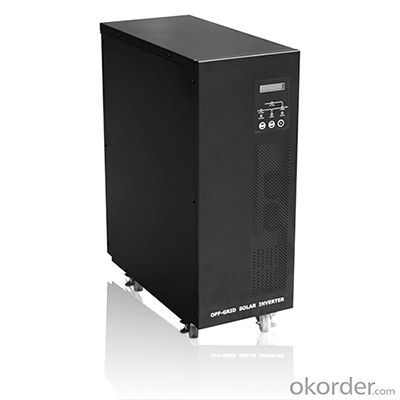

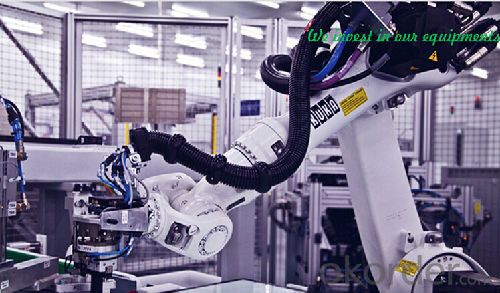

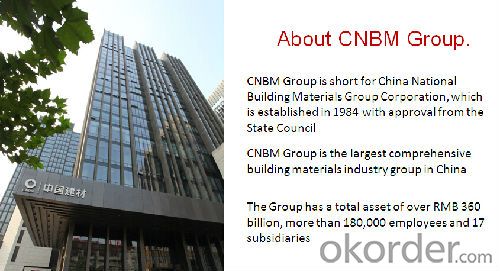

- Q:How does a solar inverter synchronize with the grid frequency?
- A solar inverter synchronizes with the grid frequency by constantly monitoring the frequency of the utility grid. It adjusts its own output frequency accordingly to match the grid frequency. This synchronization process ensures that the solar inverter's power output is in phase with the utility grid, allowing it to seamlessly inject solar energy into the grid without any disruptions or compatibility issues.
- Q:How does a solar inverter handle reactive power injection into the grid?
- A solar inverter handles reactive power injection into the grid by utilizing power factor correction techniques. It actively monitors the grid's voltage and adjusts the reactive power output to maintain a desired power factor. This ensures efficient energy transfer and minimizes any negative impacts on the grid's stability and power quality.
- Q:How does a solar inverter handle grid faults and disturbances?
- A solar inverter is designed to handle grid faults and disturbances by continuously monitoring the grid conditions. In the event of a fault or disturbance, such as a voltage or frequency fluctuation, the solar inverter will quickly disconnect from the grid to ensure the safety of the system. Once the fault is resolved and the grid conditions stabilize, the solar inverter will reconnect to the grid and resume normal operation, ensuring a reliable and stable power supply.
- Q:Can a solar inverter be used with different types of grounding materials?
- Yes, a solar inverter can be used with different types of grounding materials. Solar inverters are designed to be compatible with various grounding systems, such as ground rods, ground plates, and grounding grids. The choice of grounding material may depend on local regulations, soil conditions, and the specific requirements of the solar installation. However, it is important to ensure that the chosen grounding material meets the safety standards and provides proper electrical grounding for the solar system.
- Q:Can a solar inverter be used in a solar-powered telecommunications system?
- Yes, a solar inverter can be used in a solar-powered telecommunications system. A solar inverter is an essential component in such systems as it converts the DC (direct current) electricity generated by the solar panels into AC (alternating current) electricity, making it compatible with the telecommunication devices and equipment.
- Q:What is the role of a solar inverter in voltage and frequency regulation during islanding conditions?
- The role of a solar inverter in voltage and frequency regulation during islanding conditions is to ensure stability and balance in the electrical system. It actively monitors and adjusts the voltage and frequency levels to match the required standards, even when disconnected from the main power grid. This prevents overvoltage or undervoltage situations and keeps the frequency within acceptable limits, thereby maintaining a reliable and safe power supply in islanded conditions.
- Q:Are solar inverters compatible with different solar panel technologies?
- Yes, solar inverters are generally compatible with different solar panel technologies. However, it is important to ensure that the inverter's specifications and capabilities align with the specific requirements of the solar panels being used. Some inverters may be optimized for certain panel technologies, so it's advisable to consult with manufacturers or experts to ensure compatibility and maximize system efficiency.
- Q:How does a solar inverter handle electromagnetic interference (EMI)?
- A solar inverter handles electromagnetic interference (EMI) by implementing various measures to mitigate and minimize its impact. These measures include using proper shielding techniques, filtering the input and output signals, and complying with relevant EMI standards and regulations. Additionally, advanced digital signal processing techniques may be employed to suppress any EMI-induced noise and ensure the efficient conversion of solar energy into usable electricity.
- Q:Can a solar inverter provide power during a blackout?
- No, a solar inverter cannot provide power during a blackout.
- Q:Can a solar inverter be used in regions with high altitude conditions?
- Yes, a solar inverter can be used in regions with high altitude conditions. However, it is important to consider certain factors such as temperature variations, reduced air density, and increased UV radiation at higher altitudes. In such cases, it may be necessary to choose a solar inverter specifically designed to handle these conditions and ensure proper functioning and efficiency of the system.
1. Manufacturer Overview |
|
|---|---|
| Location | |
| Year Established | |
| Annual Output Value | |
| Main Markets | |
| Company Certifications | |
2. Manufacturer Certificates |
|
|---|---|
| a) Certification Name | |
| Range | |
| Reference | |
| Validity Period | |
3. Manufacturer Capability |
|
|---|---|
| a)Trade Capacity | |
| Nearest Port | |
| Export Percentage | |
| No.of Employees in Trade Department | |
| Language Spoken: | |
| b)Factory Information | |
| Factory Size: | |
| No. of Production Lines | |
| Contract Manufacturing | |
| Product Price Range | |
Send your message to us
Off-Grid Solar Inverter 3KW-8KW CE Approved AAA Quality with Best Price
- Loading Port:
- China main port
- Payment Terms:
- TT or LC
- Min Order Qty:
- 1 pc
- Supply Capability:
- 1000 pc/month
OKorder Service Pledge
OKorder Financial Service
Similar products
New products
Hot products
Hot Searches
Related keywords
